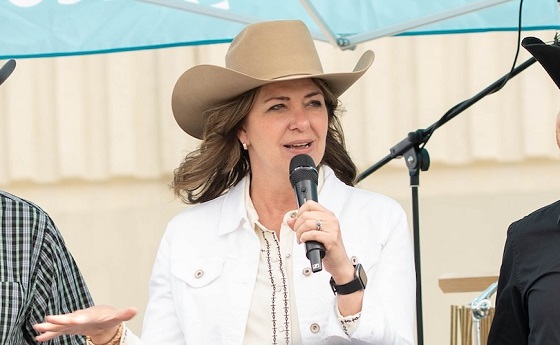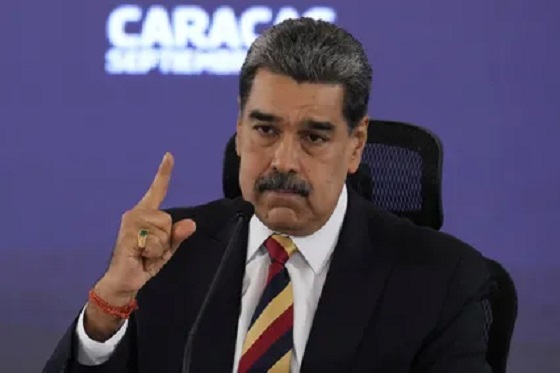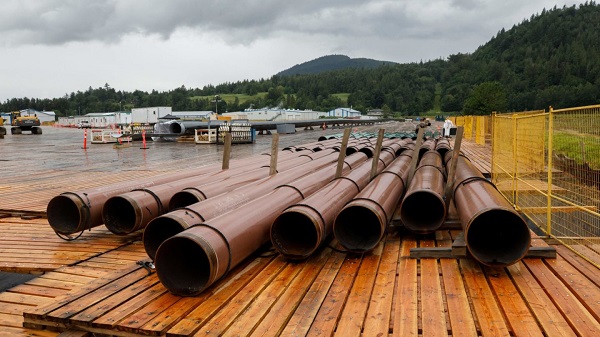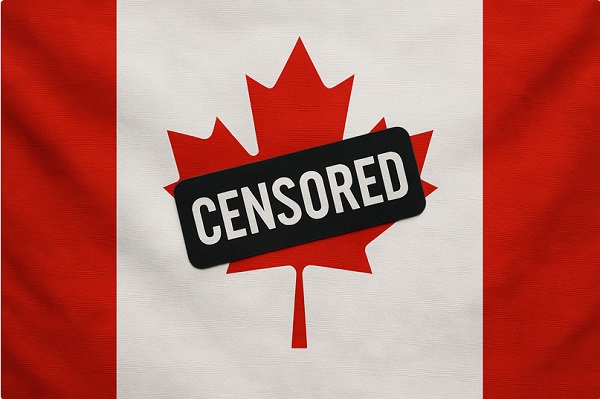Daily Caller
Trump’s Wind Diatribe Caught Von Der Leyen By Surprise


From the Daily Caller News Foundation
By David Blackmon
President Donald Trump caught European Union President Ursula Von Der Leyen by surprise during a press event announcing the US/EU trade agreement Monday when he launched into a three-minute diatribe targeting the wind industry. Von Der Leyen, a longtime German government official who held a senior position in the Angela Merkel government during its heavy expansion of that country’s vaunted Energiewende experiment, was visibly discomfited as Trump slammed the form of intermittent generation she has done so much to promote throughout her career.
Referring to the industry as “a con job,” Trump added, “It’s very expensive. And in all fairness, Germany tried it, and wind doesn’t work,” as Von Der Leyen’s polite smile faded to a stern frown. But Trump was far from finished.
“You need subsidy for wind. And energy should not need subsidy,” the U.S. President continued in the unique Queens dialect he’s retained since childhood, adding, “It’s the most expensive form of energy. It is no good. They’re made in China, almost all of them.”
For a European for whom English is a second language, Trump’s direct and often shorthand way of expressing his thoughts had to have been thoroughly confusing to the EU President, but the message was clear: On energy and the fading drive to the net-zero fantasy with which the EU and U.K. remain obsessed, Trump and America are moving in the opposite direction.
Trump and the Republican majorities in congress, through a combination of executive orders, aggressive administrative moves, and language to eliminate Biden-era tax breaks and subsidies for wind and solar in the One Big Beautiful Bill Act (OBBBA) have already essentially ended former president Joe Biden’s dreams of a vibrant offshore wind sector. Without those tax incentives and subsidies, the business plans for those massive projects are unsustainable and the sector is now seeing a flood of big companies like BP, Shell, Equinor, Orsted, and others cancelling projects and taking massive write-downs on their virtue-signaling investments.
The news for onshore wind projects is less terrible, but only marginally so. A new study published by business advisory giant FTI Consulting finds that at least 320 onshore projects with a total nameplate capacity of more than 100 GW are “no longer economically viable” in the wake of the OBBBA’s enactment. The authors go on to say that the new law will make it “significantly harder, if not impossible, to attract capital and meet key development milestones,” signaling the likelihood of a wave of capital flight out of the industry I wrote about in early July.
Trump’s critics like to claim the President’s anti-wind power stance is driven by large contributions by the “fossil fuels” industries and an irrational thought process. But the truth is that the President was a critic of the wind industry and Germany’s Energiewende endeavors long before he dreamed of running for president. Trump’s disapproval of weather-dependent forms of energy have grown out of his observations of the de-industrializing impacts they have had in Germany beginning 20-25 years ago, and, more recently, in the UK.
Trump understands that, despite claims wind is among the cheapest form of power generation, the reality is that electricity costs rise rapidly everywhere it becomes a significant part of an integrated grid. The higher power costs drive all forms of industrial operations to relocate where power is cheaper, and, as often as not, that road leads to China.
The UK has the highest cost of industrial power on earth today, and Germany isn’t far behind. Trump is perhaps a rare form of political figure who is able to connect the cause of this problem with its inevitable effect.
After watching first the Obama administration and more recently Biden’s appointees and handlers strive to take America down this same road to economic ruin, Trump is determined to not just save what remains of American industrial might after 40 years of globalism, but to rebuild it. He understands that the most effective way to drive that shift is to reverse the energy and climate policy regimes of both prior Democratic administrations.
These are thought processes that are completely foreign to a central planner like Ms. Von Der Leyen, which helps to explain her deer-in-the-headlights reaction to Trump’s diatribe about her favored wind industry.
David Blackmon is an energy writer and consultant based in Texas. He spent 40 years in the oil and gas business, where he specialized in public policy and communications.
Daily Caller
Ex-FDA Commissioners Against Higher Vaccine Standards Took $6 Million From COVID Vaccine Makers


From the Daily Caller News Foundation
By Emily Kopp
The FDA old guard criticized the new leadership in a Dec. 3 New England Journal of Medicine (NEJM) letter over a higher regulatory bar for vaccines, namely the expectation that most new vaccine approvals will require randomized clinical trials, arguing it could hamper the market.
“Insisting on long, expensive outcomes studies for every updated formulation would delay the arrival of better-matched vaccines when new outbreaks emerge or when additional groups of patients could benefit,” the former commissioners wrote. “Abandoning the existing methods won’t ‘elevate vaccine science’ … It will subject vaccines to a substantially higher and more subjective approval bar.”
But while the former commissioners disclosed their conflicts of interest to the medical journal — per standard practice in scientific publishing — reporters didn’t relay them to the broader public in reports in the Washington Post, STAT News and CNN.
The headlines about a bipartisan rebuke from former occupants of FDA’s highest office give the impression that the Trump administration is contravening established science, but closer inspection reveals a revolving door between pharmaceutical corporations and the agencies overseeing them.
Three of the signatories have received payments totaling $6 million from manufacturers or former manufacturers of COVID vaccines.
Scott Gottlieb has received $2.1 million in cash and stock from his position on the Pfizer board of directors, where he has advised on ethics and regulatory compliance since 2019, according to company filings to the Securities and Exchange Commission. Stephen Ostroff has received $752,310 from Pfizer in consulting fees since 2020, according to OpenPayments.
Mark McClellan has received $3.3 million from Johnson & Johnson as a member of the board of directors since 2013, SEC filings also show. McClellan also consults for the new pharmaceutical arm of the alternative investment management company Blackstone, which invested $750 million in Moderna in April 2025.
Gottlieb and McClellan did not respond to requests for comment. Ostroff could not be reached for comment.
FDA Center for Biologics Evaluation and Research Director Vinay Prasad outlined the higher standards and shared the results of an internal analysis validating 10 reports of children’s deaths following the COVID-19 vaccine in a Nov. 28 memo to staff. He called for introspection and reform at the agency.
The NEJM letter criticizes Prasad for cracking down on a practice called “immunobridging” that infers vaccine efficacy from laboratory tests rather than assessing it through real-world reductions in disease or death. The FDA under the Biden administration expanded COVID vaccines to children using this “immunobridging” technique, extrapolating vaccine efficacy from adults to children based on antibody levels.
Norman Sharpless — who in addition to previously serving as acting FDA commissioner also served as the head of the National Institutes of Health’s National Cancer Institute — consults for Tempus, a company that collaborates with COVID vaccine maker BioNTech. He has helped steer $70 million in investments in biotech through a venture capital firm he founded in November 2024. Sharpless also disclosed $26,180 in payments in 2024 from Chugai Pharmaceutical, a Japanese pharmaceutical company that markets mRNA technology among other drugs, on OpenPayments.
“I was grateful for the opportunity to serve as NCI Director and Acting FDA Commissioner in the first Trump Administration, and strongly support many of the things President Trump is trying to do in the current Administration,” Sharpless said in an email.
Margaret Hamburg, another former FDA commissioner and signatory of the NEJM letter, has since 2020 earned $2.8 million as a member of the board of Alnylam Pharmaceuticals, which markets RNA interference (RNAi) technology.
Hamburg did not respond to a message on LinkedIn.
Most signatories disclosed income from biotech companies testing experimental cancer treatments. These products could face tighter scrutiny under Prasad, a hematologist-oncologist long wary of rubberstamping pricey oncology drugs — which Prasad points out often cause some toxicity — without plausible evidence of an improvement in quality of life or survival.
The former FDA commissioners disclosed ties to Sermonix Pharmaceuticals Inc.; OncoNano Medicine; incyclix; Nucleus Radiopharma; and N-Power, a contractor that runs oncology clinical trials.
Andrew von Eschenbach, who like Sharpless formerly served both as FDA commissioner and the head of the National Cancer Institute, disclosed stock in HistoSonics, a company with investments from Bezos Expeditions and Thiel Bio seeking FDA approval for ultrasound technology targeted at tumors.
Some FDA commissioners who signed onto the letter opposing changes to vaccine approvals have ties to biotechnology investment firms, namely McClellan, who consults Arsenal Capital; Janet Woodcock, who consults RA Capital Management; and Robert Califf, who owns stock in Population Health Partners.
Califf did not respond to an email requesting comment. Woodcock did not respond to requests for comment sent to two medical research advocacy groups with Woodcock on the board. Eschenbach did not respond to a LinkedIn message.
The two signatories without pharmaceutical ties may find their judgement challenged by the FDA investigation into COVID-19 vaccine deaths, having either implemented or formally defended the Biden administration’s headlong expansion of vaccines and boosters to healthy adults and children.
David Kessler executed Biden’s vaccination policy as chief science officer at the Department of Health and Human Services, helping to secure deals for shots with Pfizer and Moderna.
Meanwhile Jane Henney chaired a National Academies of Sciences, Engineering, and Medicine report published in October 2025 that praised the performance of FDA and Centers for Disease Control and Prevention (CDC) vaccine surveillance during the pandemic — underwritten with CDC funding.
That assessment clashes with that of a Senate report, citing internal documents from FDA, finding that CDC never updated its vaccine surveillance tool “V-Safe” to include cardiac symptoms, despite naming myocarditis as a potential adverse event by October 2020, and that top officials in the Biden administration delayed warning pediatricians and other providers about the risk of myocarditis after their approval in some children in May 2021, months after Israeli health officials first detected it in February 2021. The Senate investigation named Woodcock, a signatory of the NEJM letter, as one of the FDA officials who slow-walked the warning.
Daily Caller
‘Almost Sounds Made Up’: Jeffrey Epstein Was Bill Clinton Plus-One At Moroccan King’s Wedding, Per Report


From the Daily Caller News Foundation
Former President Bill Clinton personally asked to bring Jeffrey Epstein and Ghislaine Maxwell as guests to the Moroccan King Mohammed VI’s 2002 wedding, a move that unsettled Clinton’s own aides, the New York Post reported Thursday.
Clinton requested permission to include Epstein and Maxwell at the royal wedding in Rabat despite neither having any official relationship with the Moroccan royal family, the Post reported. Sources told the outlet that Clinton’s request was viewed internally as inappropriate and has quietly circulated in Democratic circles for more than two decades.
“[Clinton] brought them as guests to a king’s wedding. I mean, it almost sounds made up,” one source familiar with the matter told the outlet. “How many times in your life have you been invited as a guest of a guest at a wedding?”
As a nonprofit, we are dependent on the generosity of our readers.
Please consider making a small donation of any amount here.
Thank you!

Clinton traveled to Morocco with Epstein and Maxwell aboard Epstein’s private jet, dubbed the “Lolita Express,” according to the Post. Chelsea Clinton attended separately, and then-Sen. Hillary Clinton remained in Washington due to her schedule.
“[Former First Lady] Hillary [Clinton] was in the Senate, so she couldn’t go. Chelsea very much wanted to go, and the president very much wanted to go,” a second person told the outlet. “The idea that they would take [Epstein] was a head-scratcher. But nonetheless, the Clinton office moved forward and made this request … to bring these two guests, and that’s what happened.”
Once in Rabat, Clinton, Epstein and Maxwell were seated with King Mohammed VI during the black-tie wedding dinner, sources said. At one point, Chelsea Clinton requested a group photograph that included her father, Epstein and Maxwell.
Maxwell is currently serving a 20-year federal prison sentence for sex trafficking conspiracy and related offenses. Epstein died in jail in 2019 while awaiting trial on federal sex trafficking charges. Their crimes were not publicly known at the time of the wedding.
The Clintons continue to downplay the extent of their past relationship with Epstein, maintaining that they cut off contact with him in 2005, three years before he pleaded guilty to state sex crimes in Florida.
Clinton spokesman Angel Ureña previously told the outlet that Clinton took four trips aboard Epstein’s jet between 2002 and 2003 and denied that Clinton ever visited Epstein’s private island or residences.
“I don’t know how many times we need to say there was travel more than 20 years ago before he was cut off. Apparently, we need to one more time. But nice try,” Ureña said, according to the outlet.

Neither of the sources quoted by the New York Post said they believed Clinton was aware of Epstein trafficking or sexually abusing children, but did say the ex-president is downplaying his former links to both Epstein and Maxwell.
The Clinton Foundation did not respond to the Daily Caller News Foundation’s request for comment.
Both Bill and Hillary are scheduled to give depositions in January to the House Oversight and Government Reform Committee about their ties to Epstein. The Oversight Committee subpoenaed the Clintons in August, and Committee Chairman James Comer said that if the Clintons didn’t appear for depositions scheduled for Dec. 17 and 18 or arrange to appear for questioning in early January, then contempt charges would be pursued.
Photos released by Oversight Committee Democrats in December show Epstein with prominent figures, including President Donald Trump, Bill Clinton, Microsoft co-founder Bill Gates and Steve Bannon.
The Department of Justice is expected to release a new trove of documents related to the Epstein investigation Friday.
-

 Crime2 days ago
Crime2 days agoBondi Beach Survivor Says Cops Prevented Her From Fighting Back Against Terrorists
-

 Automotive2 days ago
Automotive2 days agoFord’s EV Fiasco Fallout Hits Hard
-

 Frontier Centre for Public Policy1 day ago
Frontier Centre for Public Policy1 day agoCanada Lets Child-Porn Offenders Off Easy While Targeting Bible Believers
-

 Alberta2 days ago
Alberta2 days agoDanielle Smith slams Skate Canada for stopping events in Alberta over ban on men in women’s sports
-

 Agriculture1 day ago
Agriculture1 day agoWhy is Canada paying for dairy ‘losses’ during a boom?
-

 Business1 day ago
Business1 day agoCanada Hits the Brakes on Population
-

 International2 days ago
International2 days agoTOTAL AND COMPLETE BLOCKADE: Trump cuts off Venezuela’s oil lifeline
-

 Agriculture1 day ago
Agriculture1 day agoCanadians should thank Trump for targeting supply management






